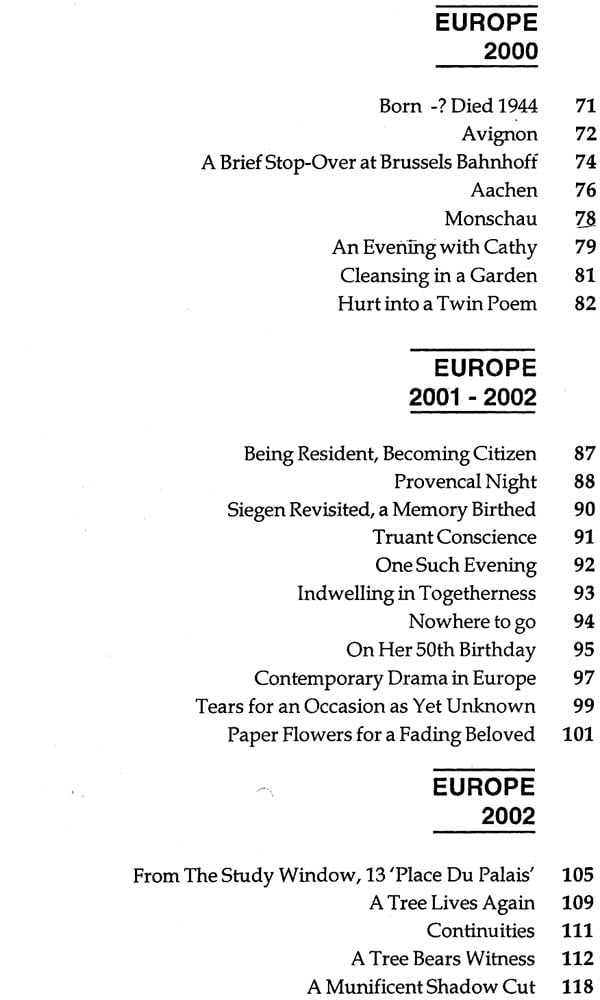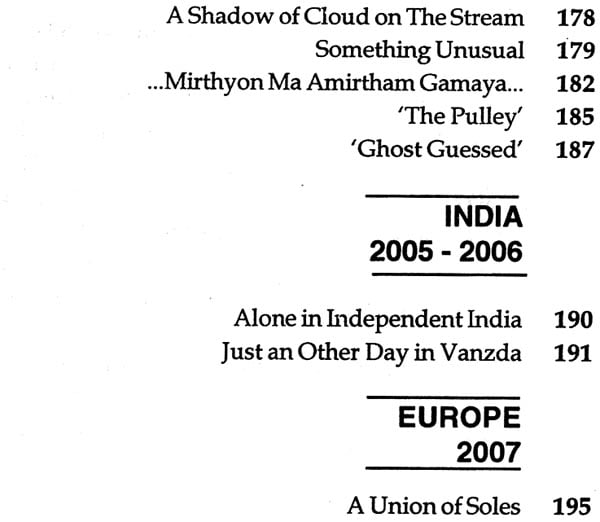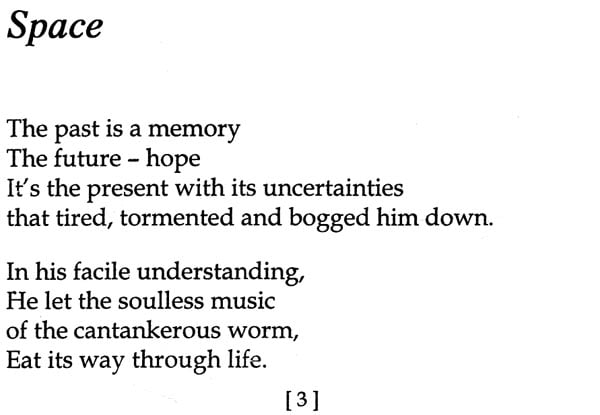
Cracked Images Frozen Frames (A Collection of Poems)
Book Specification
| Item Code: | NAU234 |
| Author: | Sridhar Rajeswaran |
| Publisher: | National Publishing House |
| Language: | English |
| ISBN: | 812140441X |
| Pages: | 196 |
| Cover: | HARDCOVER |
| Other Details | 9.00 X 6.00 inch |
| Weight | 350 gm |
Book Description
Poetry for Sridhar Rajeswaran might begin with the self but then it always moves on to the larger other. His poems incarnate in their very lines the process of creation that transforms individual instance in to its final aesthetic structure. They reveal a mental equipoise that does not disintegrate the emotion of the moment, but instead makes it a part of an earlier pattern.
As a Postcolonial Indian who has composed his poetry against the backdrop of various spaces stretched across a canvas of time, the poems reflect his ideological concerns with issues relating to race, religion, caste and gender. The European spaces in which much of his poetry has been birthed, have provided him with the opportunity to reach out to a poetic self which is at once local as well as global. The poems written in the Arab world on the other hand are focussed on interior spaces and a theoretical position brought out through passive observation as his location there was as the ultimate other and this denied him entry into the wider reality of that world.
Sridhar Rajeswaran’s poetry deliberately avoids specific references to Indian myths, or the use of Indian English, or Indian language lexis, as his location he believes is a sufficient marker of his nationality, culture and civilisation.
Sridhar Rajeswaran was born in 1960 in Calcutta. He has studied at the Universities of Madras and Bombay.
He has been published in reputed academic journals and critical anthologies in India and abroad and has presented papers at international conferences in Britain, Germany, Belgium and Austria.
Dr. Sridhar is currently Adjunet Faculty, in the Department of English, University of Mumbai. He is also a Visiting Professor of English in the Faculty of Arts, University of Hodeidah, Yemen. He is also on the global Faculty of the Fairleigh Dickinson University, USA from 2004 onwards. He has lectured on Yeats and Postcolonial Theories at the Universities of Magdeburg and Cologne, Germany and conducted creative writing workshops at the University of Siegen, also in Germany. He has taught Indian drama and poetry to Postgraduate students at the University of Avignon, France.
From 2004 onwards Dr. Sridhar has been engaged in a joint research project with the University of Dusseldorf, Germany, on the topic of ‘Women and Ageing’.
Dr. Sridhar’s engagement with creative writing began at an early age and his plays were performed while he was still at college. They have also been broadcast over the All India Radio and been read in professional theatres in Mumbai. He is member of the Association of Contemporary Drama in Europe with which he has been associated for the past 8 years.
His poetry has been published widely in India and abroad. It is also available on the websites of the Siegen, Cologne and Dusseldorf Universities in Germany for the summer semester of 2006-07.
Images have their own lives:
perfunctory,
perennial.
One passes in a blur, the other stays on.
One that stays on —
seeks a life,
a span of being.
Beings seek their representations in subterranean ways. Ways that sometimes surprise even their creators. They find their own modes of expression. Now in the ebullience of a word, now in the stroke of an expression, now in the secularity of an experience. While the creator wishes to discover a mode, the mode finds itself out, and represents the creator. A mysterious process of identification indeed! Identification of the being, or of the image, or of the creator? The answer eludes often. For there is no answer. At least not the final one to seek in Sridhar Rajeswaran’s poetry that is composed in frames of place and space, in trajectories of time and timelessness.
Rajeswaran’s engagement with his word and expression is.one of the very primordial kind. He has an image, a definite one, to represent. This image seeks its own tones in shifting moods and free association of ideas, otherwise called memory. It is sometimes solitary, sometimes in the company of the likes. It represents a state of being, a state that no other state can efface. It reflects, at times, a certain sense of loss, at times, a sure sense of fulfillment. Rajeswaran’s is the poetry of myriad forms of being and nothingness.
Rajeswaran’s poems are self-engaging on the canvas of a page, indulgent in the company of a reader. The poems are invariably expressive; never at aremove from the poet or the reader. I read his poems in silence, I lend them a voice when I wish, only to find that they always resonate. Resonate with sounds and images, of here and now, then and there. Faiths converge in his poetry, political configurations surface, echoes find ears. The poems yearn to communicate, to move beyond the barriers of the self. The composition on a page is more than a single representation of life’s myriad correlates in ironical configurations, convergences of images, impressions collected in time and beyond. His poems are pensive at times, at times interrogating, but always engaged and engaging. Here is a poet with creative exuberance of a very individual kind. And this is what makes his poetry his own. The poet is in intimate rapport with himself. And this helps me develop the same rapport with the poet. These are secular poems for sure, poems of affirmation, of knowing life from recognizably close quarters.
In companionship with space—India, Europe, Yemen—as also in camaraderie with time —1998—2007—Rajeswaran’s poems gather grace. Now they move hand in hand; now they sit in close communion, now lie together in a graceful embrace even while they retain their own identities. This process extends further in various acts of seeing and feeling. The poet celebrates the states of being—of hope and faith—amidst uncertainties spread all over. His counters of expressions are like colours on canvas; he allows them to acquire their own tones even in the company of other colours. His poems represent life’s myriad possibilities, its infinite varieties. The poems are remarkable for their form and spirit; they are rooted in personal histories, communal chronologies, literary traditions. They are very different from the poems one often reads; they are eerie and uncanny; they are atypical and weird but always out of the ordinary, always real.
**Contents and Sample Pages**















